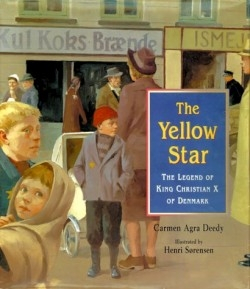The Yellow Star
The Legend of King Christian X of Denmark
While the persecution of Jews during Nazi rule is not a subject normally associated with young children, there comes a time when this distasteful period in world history must be broached. While we might prefer to shield our children from awful truths, we cannot risk ignorance. This book, which tells a legend associated with the Nazi occupation of Denmark, provides an interesting foothold into the not so distant past.
Every morning King Christian of Denmark rides unarmed and alone through the streets of Copenhagen. When the Nazi’s arrive, bringing food shortages and curfews, they also bring their flag, hanging it high on the palace roof. With steely defiance and courage the King has the flag permanently removed.
Having thus established this simplified baseline by which wartime occupation can be understood, readers are then drawn further into the demands and injustice of this time. Leaflets flutter down on the city of Copenhagen demanding that all Jews must sew a yellow star onto their clothing. Having heard horrible stories, “In some places, once Jews wore the yellow star, they were taken away and not heard from again,” the people of Denmark were frightened. So too is the King. Having previously experienced King Christian’s bravado, this simple statement of fear allows readers to more fully comprehend the gravity of this new situation. The solution to this divisive edict is seemingly simple, King Christian decides to sew a star on his own clothing. Readers are shown this rather than told. As King Christian boldly rides through the streets, a star on his lapel, his people understand the implications and follow their leader’s example. Now, with stars visible on all of the people, “once again, in the country of Denmark, there were only Danes.”
This book’s focused and simplified approach allows children to be exposed to an unpleasant subject without feeling threatened. As an author’s note so eloquently explains, “The allegory of the yellow star used by the Nazis to divide and shame became in this legend a symbol of unity and hope.” The author’s note also clarifies to readers the definition of a legend spelling out the difference between fact and unauthenticated storytelling. While there is no hard evidence that King Christian ever wore the Star of David, a few other facts of how Danish Jews fared during the war are given. A Website link for more information is provided.
The interaction between the art and text is seamless and attractive. The text is set in a framed rectangular box that runs vertically down one quarter of the open page. The art smoothly envelops the rest of the double page spread. The art sets a sober and dignified tone. Two pages show generalized monochromatic scenes of how damaging war can be, the rest of the art remains focused in Denmark. Sorensen, an accomplished illustrator, is a native of Denmark. The respect he has for his fellow Danes is clearly expressed through the many group and individual portraits. He is able to capture the austerity of the times while creating a strong sense of place.
The thoughtful story and heartfelt illustrations will involve elementary age children in this legend while exposing them to harsh truths.
Reviewed by
Martha Topol
Disclosure: This article is not an endorsement, but a review. The publisher of this book provided free copies of the book to have their book reviewed by a professional reviewer. No fee was paid by the publisher for this review. Foreword Reviews only recommends books that we love. Foreword Magazine, Inc. is disclosing this in accordance with the Federal Trade Commission’s 16 CFR, Part 255.

